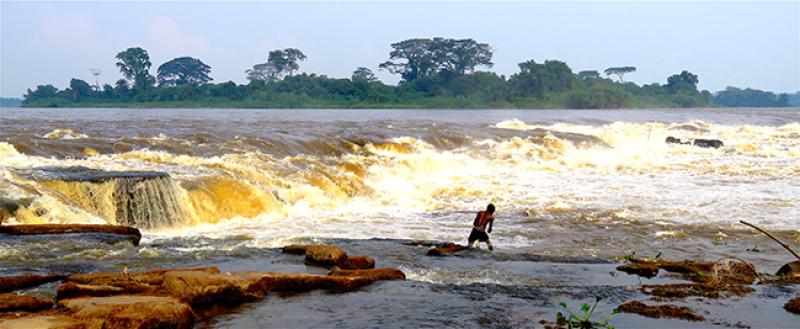Bilingual monograph sets table for new discoveries in the Congo


In the heart of Africa, the rivers and tributaries of the Congo River Basin snake through the lush wetlands and tropical rainforests. At over 1.4 million square miles, the Congo is one of the world’s largest basins — second only to the Amazon — and its impacts reverberate across the African continent.
And yet, unlike the Amazon, the Congo is not as widely researched. For every peer-reviewed hydrology study on the Congo, there are 10 on the Amazon.
Doug Alsdorf, a professor in the School of Earth Sciences, hopes that changes thanks to a comprehensive monograph titled, “Congo Basin Hydrology, Climate, and Biogeochemistry: A Foundation for the Future,” published recently by the American Geophysical Union (AGU).
The historic 600-page monograph provides a broad overview of current and archival fieldwork extending from the Congo River and across the basin. Published in English and French, it is the AGU’s first-ever bilingual publication. It culminates nearly a decade’s worth of international collaboration that included 109 scientists — more than 40 of whom live and work in the Congo — about 50 referees, two translators and around two dozen staff from the Ohio State’s Byrd Polar and Climate Research Center, the AGU and the authors’ institutes.
Together with fellow co-editors Guy D. Moukandi N’kaya of Marien Ngouabi University and Raphael M. Tshimanga of the University of Kinshasa, Alsdorf is eager for the monograph to open doors for collaboration across diverse scientific communities to probe important climatic, ecological and hydrological questions about the Congo.
There are so many things in the Congo that are waiting to be understood,” Alsdorf said. “The monograph, as the title says, is a foundation for the future. It is not the solution to everything. It’s the foundation upon which a new scientist, a graduate student, a postdoc, can come along and find opportunities.”
Compared to the Amazon, the Congo is rife with unanswered questions. At first glance, the two basins appear similar. But pulling back the curtain — even a little bit — reveals a host of distinctions, presenting a wealth of potential for discovery. For example, the Congo is higher in elevation than the Amazon or the Mississippi. How does that influence the Congo’s atmospheric processes or how its rivers and streams are governed? How is water exchanged between the Congo River and its surrounding wetlands? What role does precipitation play? What hydrodynamic factors affect carbon exchange, and to what extent?
As anthropogenic change intensifies and resource management becomes more vital, understanding and answering these questions is imperative. With the monograph, Alsdorf, Moukandi N’kaya, Tshimanga and their colleagues have set the table, welcoming new scientific discoveries, new collaborations and more informed resource management.
“This is about the community of really amazing researchers moving forward as a group,” Alsdorf said. “We’ve got 28 chapters. Some of those will flourish and people will want to build on those. … I can’t predict the future. But I do think we’ve laid the groundwork for inviting many others to participate together as a community.”
That groundwork began in 2014 when Alsdorf connected with Tshimanga after reading one of his papers on the Congo. Two years later, the pair collaborated on a paper laying out opportunities for hydrologic research in the Congo published in Reviews of Geophysics, which gave way to the 2018 AGU Chapman Conference in Washington, D.C. With critical administrative and financial support from the Byrd Polar and Climate Research Center, Alsdorf and his growing team of colleagues were able to bring 25 scientists from sub-Saharan Africa to the Chapman Conference, where they began sketching out what eventually became the finished monograph.

“The Byrd Center coordinated all those logistics,” Alsdorf said. “When I said that I had researchers who live around Lake Chad and in Kinshasa, Africa, and they need to get to Washington, D.C., and back, it was no problem. The Byrd Center handled it. … None of this would have happened without the Byrd Center — none of it. They deserve a tremendous amount of praise.”
So too, Alsdorf says, do the researchers in the field. Alsdorf is a self-described conduit, a facilitator for connection. Though he helped lead the monograph, refine its scope and unify its authors, he owes the achievement to the researchers in the field who collected data and scoured archives.
“I’m not actually the person doing the work. The authors in the monograph, they are doing the work,” he said. “What this monograph did was it brought all of us together. It was beautiful — everyone was so eager to share.”
